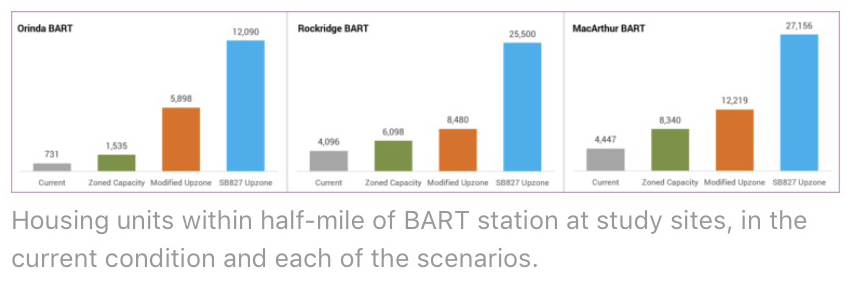Joe DiStefano at the Urban Footprint blog ran a useful experiment to see how the transit-oriented upzoning proposed in SB 827 would affect three station neighborhoods in the San Francisco Bay Area’s BART system. All three stations are in the East Bay but are somewhat distinct:
- Orinda is a low-density suburban commercial and residential stop
- Rockridge is a medium-density, largely suburban stop
- MacArthur is a more urbanized commercial stop
The analysis included an assessment of what housing units are currently built in the 1/2 mile radius of the stop, how much capacity would be legal to build under current zoning, what would happen if only commercial areas were rezoned and not single-family homes and townhomes, and what would happen if the full upzoning allowed under SB 827 took place.
Here are the results (apologies for the blurry screengrab — check out the site for a better image):
 The bottom line is that under SB 827, potentially 48,000 additional new units could be built, just within 1/2 mile of these 3 station areas. It demonstrates the power of upzoning near transit to build enough housing to accommodate future population growth and stabilize prices for existing residents.
The bottom line is that under SB 827, potentially 48,000 additional new units could be built, just within 1/2 mile of these 3 station areas. It demonstrates the power of upzoning near transit to build enough housing to accommodate future population growth and stabilize prices for existing residents.
And even if single-family homes and townhomes didn’t redevelop (either because the owners didn’t sell or the bill eventually gets amended to prevent development there), the state could still see over 10,000 new units in the “modified upzone” scenario — again, just at 3 station neighborhoods.
Caveats are of course necessary: not all of these units would be built, even under the full scenario. Property owners wouldn’t sell in some cases, developers wouldn’t maximize density and height on all lots, other local restrictions may prevent some of the units from getting built, and the final bill may contain additional restrictions that would limit a full build-out.
But this analysis indicates the power of upzoning near transit to help solve California’s dire housing shortage. Given the importance of this issue to California’s environmental and economic health, solutions like SB 827 are well in order, as this analysis shows.


